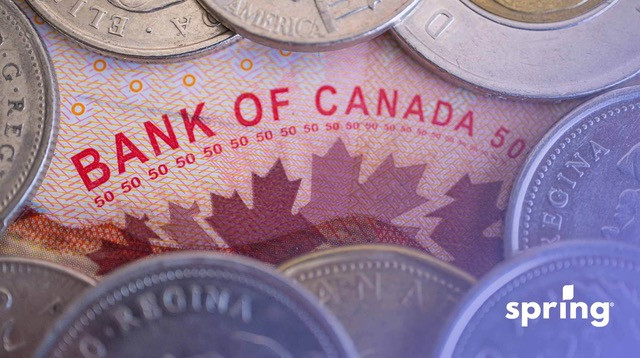Whether you’re raising one child, multiple children, or welcoming a newborn into the world, there’s a universal truth that all parents learn pretty fast: Your expenses climb and climb and climb. And climb!
Sometimes, it can be hard to make ends meet. Even if you’re doing well financially, as a parent, you want to make every dollar count because you also carry a responsibility to manage your money wisely so that you can invest in the long-term well-being of your kids. This includes saving for their education, rainy days, and even your own retirement—so they don’t have to support you later in life.
It’s no wonder the words “tax time” annually send shivers down the spines of parents from coast to coast. If you know you’re going to owe, the thought of shelling out more of your hard-earned money can be incredibly stressful. And even if you know you’ll be getting a refund, you’re probably stressed about how to maximize the amount.
The good news is this: the Canada Revenue Agency offers several different ways for eligible families in all situations to lower their tax burden, reduce the amounts they owe, and maximize their potential refunds.
Whether you’re filing taxes with a new baby, a child, or several children, here are a few essential tax tips and family benefit programs every Canadian parent should know to gain tax benefits.
1. Put Extra Money In Your Pocket With The Canada Child Benefit (CCB)
There are a lot of reasons to make sure you file your taxes each year (for starters, it’s the law) but if you’re a parent the Canada Child Benefit, also known as the Child Tax Credit, is a great motivator.
The Canada Child Benefit is a monthly, tax-free payment given to parents for each child under 18 years of age they have. It’s partly based on your taxable income reported in your tax return of the previous year, so you must keep doing your taxes to be eligible for CCB payments.
Depending on your family income thresholds, the CCB amount can be an extra few hundred dollars in your pocket each month. The maximum amounts change each year, so be sure to check the official CCB website for current estimates.
Read more: How To Get A Cash Advance On Your Child Tax Credit Benefit (Aka Baby Bonus)
2. Open a Registered Education Savings Plan (RESP)
Canadian parents can save for their children’s post-secondary education with a Registered Education Savings Plan (RESP). An RESP is very useful for taxation purposes because you can earn interest on your contributions tax-free.
There is no maximum annual contribution but since the Canada Education Savings Grant (CESG) matches 20% of your RESP contributions to a maximum of $500 per year, you only need to contribute $2,500 annually to enjoy full benefits.
For example, if you contribute $500 in one year, the government will give you $100 in grant money. Deposit $2,500 and you’ll get the full $500. Keep in mind the CESB has a lifetime limit of $7,200 per child.
The money in the RESP will not be taxed until money is withdrawn to pay for your child’s education. But, since your child will presumably belong in a lower tax bracket, you’ll pay almost nothing in taxes.
The maximum RESP contribution is $50,000 per beneficiary.
Read more about the Registered Education Savings Plan (RESP) here.
3. Claim Your Child Care Expenses
The number one way to reduce the amount of taxes you’ll owe, or help obtain your maximum refund, is to claim the amount you spent on childcare as tax deductions. From daycare to nursery schools to boarding schools and other related expenses, make sure you save every single receipt.
By claiming these expenses, you could be entitled to money back, which will either lower the amount owing on your tax return or increase the refund you’ll receive.
For more information on claiming childcare expenses, click here.
4. New Parent? Claim Your Medical Expenses
If you have had a baby since the last time you filed your taxes, you can claim some of the costs you might have incurred. For instance, if you invested in prenatal care with a nurse or upgraded to a private room at the hospital, you can claim these expenses in your tax return.
Additionally, if you went through fertility treatments—such as an IUI or IVF—you can claim those expenses as well on your tax return. Many people don’t realize these are expenses you can claim, so if you discarded your receipts for these treatments, try contacting your fertility specialist’s office and asking if they can send you another copy.
Read more: Maternity Leave Loans & Benefits: What To Expect When You’re Expecting
5. Take Advantage Of Unused Tuition Amounts
If you’re the parent of an older child who’s in post-secondary school, you might be able to leverage their unused tuition amounts. Tuition amounts are intended to help parents and students alike manage the rising cost of post-secondary education. These don’t have to be university or college tuition amounts either, just post-secondary education.
Regardless of who is paying the tuition, your child (the student) must claim their tuition fees paid on their own tax return first, but if they have a lower net income, they won’t be able to claim the full tuition amount. In this case, the student can transfer the unused tuition amount to a parent, grandparent, spouse, or common-law partner.
If you’re a parent who is paying for their child’s tuition and/or providing room and board, asking them to transfer their unused tuition amounts to you since they can be transferred to family members is a smart way to lower your tax burden. Unused amounts can also be carried forward to the next tax year.
6. Get Federal Sales Tax Back With The GST/HST Credit
The goods and services tax/harmonized sales tax (GST/HST) credit is a tax-free payment that helps families with low to modest incomes offset all or part of the GST or HST they pay. In 2025, the maximum annual amount you can receive is $519 if you’re single, $680 if you’re married or living common-law, and $179 for each child under the age of 19. The amounts are based on your family’s income, the number of children you have registered for the Canada child benefit, and the GST/HST credit. You don’t have to earn income, just receive income. You don’t need to apply for this credit, as eligibility is automatically determined when you file your taxes. If you qualify, you’ll receive quarterly payments in July, October, January, and April.
Read more: Who Is Eligible For The GST/HST Credit & How Much Can You Get?
Need cash today?
Spring Financial offers personal instalment loans of up to $35,000 and payment plans up to 60 months. Apply in 3 minutes and get the money e-transferred to your account within 24 hours!
7. Take advantage of unused tuition amounts
If you’re the parent of an older child who’s in post-secondary school, you might be able to leverage their unused tuition amounts. Tuition amounts are intended to help parents and students alike manage the rising cost of post-secondary education.
Regardless of who is paying the tuition, your child (the student) must claim their tuition fees on their own tax return first, but if their income is too low, they won’t be able to claim the full tuition amount. In this case, the student can transfer the unused tuition amount to a parent, grandparent, spouse, or common-law partner.
If you’re a parent who is paying for their child’s tuition and/or providing room and board, asking them to transfer their unused tuition amounts to you is a smart way to lower your tax burden.
8. Get federal sales tax back with the GST/HST credit
The goods and services tax/harmonized sales tax (GST/HST) credit is a tax-free payment that helps families with low to modest incomes offset all or part of the GST or HST they pay. In 2024, the maximum annual amount you can receive is $496 if you’re single, $650 if you’re married or living common-law, and $171 for each child under 19. Amounts are based on your family’s net income and the number of children you have registered for the Canada child benefit and the GST/HST credit. You don’t need to apply for this credit, as eligibility is automatically determined when you file your taxes. If you qualify, you’ll receive quarterly payments in July, October, January, and April.
Read more: Who Is Eligible For The GST/HST Credit & How Much Can You Get?

9. Benefit From Tax Relief With The Canada Workers Benefit
Are you a low-income worker? If so, the Canada Workers Benefit (CWB) is a refundable tax credit you can claim when you file your taxes. The CWB also includes a disability supplement if you have an approved Disability Tax Credit Certificate (Form T2201) on file with the CRA.
The benefit offers up to $1,516 for single individuals and $2,616 for families. Keep in mind you no longer qualify for the CWB when your individual net income is more than $35,095, or your family net income is over $45,934. Maximum amounts are also different for residents in Alberta, Nunavut, and Quebec.
If you’re eligible, you can request 50% of your benefit as an advance payment, which is paid out in April, July, October, and January.
Read more: Canada Workers Benefit (CWB): How It Works, Eligibility & Advance Payments
10. Offset The Cost Of Childcare With Disability Benefits
You’re probably familiar with the Disability Tax Credit (DTC) if you’re caring for a child with a physical or mental impairment, but did you know you could also collect a supplementary amount called the child disability benefit? The benefit is a tax-free monthly payment providing up to $3,332 annually (July 2024 to June 2025) for each child who is eligible for the DTC. Payment amounts depend on the number of eligible children, adjusted family net income, and marital status. There is no need to apply for this benefit as you’ll automatically receive it if you’re already getting the Canada child benefit for your DTC-eligible child.
Read more: Disability Tax Credit: Who Qualifies, How Much Is It, and How to Apply
11. Look Into Children’s Special Allowances If You’re A Foster Parent
Government agencies and institutions that care for children (i.e. children’s aid societies) can qualify for Children’s Special Allowances (CSA). Monthly CSA payments are equivalent to the maximum Canada child benefit payment plus the child disability benefit. Individual caregivers such as foster parents can’t apply for this program on their own, however, licensed agencies can submit applications and send CSA payments straight to foster parents. If you’re choosing to adopt, you can write off the adoption expenses as well.
12. Don’t Forget About Provincial and Territorial Benefits
In addition to federal tax relief programs, each province and territory offers its own children and family benefits. From the BC climate action tax credit to Quebec’s Child Assistance Payments to the Ontario Trillium Benefit, there are a variety of benefits you may be eligible for depending on where you live. Check out the Government of Canada’s website for a full list.
13. Children’s Fitness Tax Credit
Depending on where you live in Canada, some provinces still allow you to claim children’s fitness and activities on your income tax return. Due to the fact that the cost of raising children is high, you can claim up to $500. That said, it’s important to note that these tax breaks are only available in parts of Canada.
Tax Tips For Parents
Most of the above tips apply to all parents, whether they’re together, separated, or single. There are some special considerations, however, that single parents should be aware of.
Claiming Your Child As A Dependent
If you’re a single parent, you might be eligible to claim your child for an eligible dependant amount. You can only claim one dependent at a time, so if you have multiple children, you can only claim one as a dependent. Doing this will reduce what you owe to the CRA. To be eligible, the child must be 18 years or younger and live in the same residence as you.
Claiming Your Child As A Dependent If You’re Separated
If you’re separated from your spouse and share custody, only one of you can claim an eligible child as a dependent. If you share custody of two eligible children, each parent can claim one as a dependent. If either parent pays child support, that parent is ineligible to claim a child as a dependent.
Claiming The Canada Child Benefit When You Share Custody
If you’re a single parent who doesn’t share custody, you can receive the full amount of the Canada Child Benefit. In a shared custody situation, it’s still possible to receive the benefit, but you might have to split the benefit so that each parent receives 50%. In some cases, it goes to the lower-income spouse or parent.








